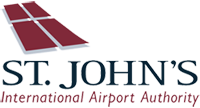Airport Improvement Fees
St. John’s International Airport has an Airport Improvement Fee (AIF) that is built in to the price of your airline ticket (departing passengers only). Revenues from the AIF are used to improve the infrastructure of the Airport in order to serve you better and allow us to keep pace with the air transportation needs of our province. The Airport Authority is contractually obligated to only use the AIF to finance capital projects that are required to construct or improve airport infrastructure that will directly benefit air travellers.
Since privatization, the Airport Authority has invested $336 million in capital improvements to provide a safe, efficient airport that is capable of handling the travel demands of the region and to enhance the level of service for passengers. These capital improvements are funded through long-term debt financing, including bond and bank financing. These credit facilities are serviced and repaid with revenues generated through Airport Improvement Fees.
Although the Airport Authority has spent $336 million to date, we have only collected 63% of this total in AIF fees. It was important to make these investments in our Airport in advance of collecting the total costs associated with them so that passengers would enjoy the improvements sooner rather than later.
Highlights of the Airport Improvement Program since privatization include the following:
| New Airport Terminal Building | 2002 |
| Flight Information Display System | 2002 |
| Upgrade of Combined Service Building | 2005 |
| New Visitor Information Centre | 2006 |
| Central De-icing Facility | 2007 |
| 4th passenger loading bridge | 2007 |
| Upgrade of snow-clearing and ice control equipment | 2007 |
| Runway 16/34 rehabilitation project | 2007 |
| Common-use self service kiosks | 2008 |
| Central De-icing Facility Operations Building | 2008 |
| Installation of low-visibility taxiway lighting system | 2009 |
| 5th passenger loading bridge | 2011 |
| Common Use Passenger Processing System (CUPPS) | 2011 |
| Airport Terminal Apron upgrade | 2011 |
| Expanded Airport Terminal Building Apron | 2012 |
| Expanded vehicle parking lot | 2012 |
| Ramp Services & Cargo Building | 2013 |
| New airport access road (“World Parkway”) | 2013 |
| Category III Instrument Landing Systems & Primary Runway Rehabilitation | 2015 |
| New and Expanded Rental Car Parking Lot | 2016 |
| Terminal Building Expansion | 2018 |
| Hold Bag Screening System | 2020 |
The Airport Improvement Program was implemented to ensure the level of passenger traffic could be facilitated. Its goal was to enhance the Airport’s facilities, services and to expand our roadways and parking lots. Improvements include additional food and beverage options; more comfortable seating areas; a larger pre-board screening area; additional gates to accommodate more aircraft; additional passenger loading bridges and additional parking availability.
In addition, improvements were made to the primary runway under the Accessibility and Safety Initiative. Category III Instrument Landing Systems were installed and maintained by NAV CANADA that allow aircraft to land and take-off in conditions of very low visibility. The $37.3 million project was jointly funded by the Airport Authority, the Government of Newfoundland and Labrador and the Government of Canada, through Canada’s Gateways & Border Crossings Fund in support of the Atlantic Gateway & Trade Corridor Strategy.
In order to finance these investments, the Airport Authority has developed a 10-year Financial Plan that includes long-term debt facilities with policies in place to ensure the long-term financial sustainability of the Airport. The Airport Authority secured a $60 million private placement bond and a $40 million line of credit. The Airport Authority’s primary source of revenue to finance its long-term debt and credit facilities is the AIF paid by each enplaning passenger. Effective January 1, 2021, the AIF is $42 for each enplaning passenger at St. John’s International Airport.
The Airport Authority will continue to implement improvements in consultation with our partners and stakeholders so that the Airport, the “gateway to the province”, can facilitate economic growth and conveniently serve the community into the future.




